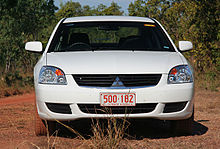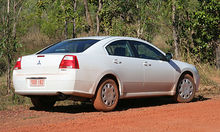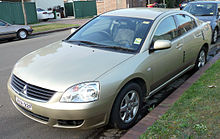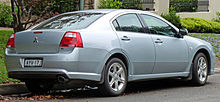- Mitsubishi 380
-
Mitsubishi 380 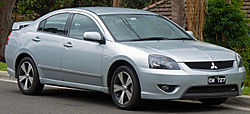
Manufacturer Mitsubishi Motors Australia Production 2005–2008 Assembly Clovelly Park, South Australia, Australia Predecessor Mitsubishi Magna/Verada Class Mid-size car Body style 4-door sedan Layout FF layout Platform Mitsubishi PS platform Engine 3.8 L 6G75 V6 Transmission 5-speed manual
5-speed automaticWheelbase 2,750 mm (108 in) Length 4,837 mm (190.4 in)–4,855 mm (191.1 in) Width 1,840 mm (72 in) Height 1,480 mm (58 in) Curb weight 1,625 kg (3,580 lb)–1,670 kg (3,700 lb) Related Mitsubishi Galant The Mitsubishi 380 is a mid-size car that was produced by Mitsubishi Motors Australia (MMAL) between 2005 and 2008. It was the successor to the Mitsubishi Magna/Verada line of vehicles first introduced in 1985. The company spent over A$600 million developing and producing the car, which is heavily based on the ninth generation Mitsubishi Galant designed in the United States.[1] The 380 continued the MMAL tradition of producing front-wheel drive sedans for the Australian market, and along with the Toyota Aurion, competed against the rear-wheel drive Ford Falcon and Holden Commodore vehicles.
Even before the car's launch, the 380 was stigmatised as the "make or break" model for MMAL.[2] After a slow sales start, the line-up was updated with the Series II on April 28, 2006, with the entry level model receiving price discount of nearly 20%.[3] To generate further interest in the car, a Series III revision came on July 29, 2007 with mainly cosmetic changes.[4] These updates failed to lift sales, and with production still unprofitable MMAL ceased manufacture of the 380 in March 2008.
Contents
History of development
The development of the DB series Mitsubishi 380 began in 2002, when company executives in Japan gave approval to MMAL to commence work on two closely related vehicles. The first of which was a right-hand drive variant of the ninth generation Mitsubishi Galant, designated the codename PS41. This was to be the replacement for the Magna and Verada. The second, which was planned to be launched in 2007 was a long-wheelbase version known internally as PS41L to be produced in both left- and right-hand drive configurations.[5] However, as Mitsubishi's financial woes worsened, and DaimlerChrysler pulled-out of the DaimlerChrysler-Mitsubishi alliance, PS41L was abandoned in 2004 and the likelihood of PS41 making it into production looked doubtful. Company research conducted in mid-2004 revealed that 84 percent of Australians believed that Mitsubishi would cease production in Australia. To reinstate consumer confidence in the brand, before the launch of the 380, a series of television commercials began airing in December 2004.[6] Centralised around Mitsubishi Australia’s then CEO Tom Phillips, the advertisements promoted the introduction of an industry-first five-year/130,000 kilometre warranty. Mitsubishi reworked a slogan from former Chrysler chairman Lee Iacocca, concluding their commercials with the tagline, "if you can find a better-built, better-backed car anywhere, then buy it".[7]
In total, A$600 million was spent on developing the 380, including $250 million on upgrading the Adelaide production facility to manufacture the vehicle.[8] This included the installation of a new body press, casting the body sides from an individual piece of steel. This has the effect of producing a 0.7 millimetre (0.03 in) size differentiation from body-to-body, compared to the industry standard of 1.0 to 1.5 millimetres (0.04–0.06 in) in 2005.[9]
Design
From the very beginning of the project, Mitsubishi had always intended that the PS41 would be set apart from the North American Galant in terms of exterior styling. The problem was that PS41 had to share the same basic foundation and the side profile was to remain for the most part unchanged. A revamp of the Clovelly Park facility allowed for the use of more robust bodies. The consequence of this is the tooling required to produce the panels. This gave MMAL the opportunity to make several low key variances to the design. These came in the from of larger front guards, a revised bonnet, new headlamps as well as grilles and bumpers.[10]
The front-end of the PS41 was originally penned by Mitsubishi's design chief, Olivier Boulay. Boulay was also responsible for the 2003 Magna/Verada facelift, but this update fared poorly with buyers. When DaimlerChrysler pulled out of their alliance with Mitsubishi in 2004, it put an end to Boulay-designed Mitsubishis. This allowed for one final chance to progress the exterior design. However, with little more than a year until production, the redesign was shared between MMAL and its parent in Japan. The basic design was devised by the Japanese studio, with the sports oriented design conceived locally.[11]
Engineering
Compared to the Galant, there were changes to 70 percent of the car to create a car more suited to the Australian market.[12] Roads, legislation and consumer preferences were all driving forces behind the changes.[13] The rear of the floorpan had to be overhauled to accommodate a full-sized spare wheel, and superior rear sidemembers were required to improve towing capabilities. Body rigidity was also improved to deal with Australian road conditions. The improved body stiffness resulted in better vehicle dynamics, which were also supported through the use of sophisticated suspension designs, new shock absorbers and stabiliser bars.[14]
The 380 was a sedan only, and was powered by an all-new 6G75 3.8 litre V6 engine. Unusually, the sports model did not have a more powerful engine than the cheapest entry level model. The five-speed manual 380 ES (a five-speed sequential automatic was optional on the ES) was actually the fastest vehicle in the range. The 175 kilowatts (235 hp) and 343 N·m (253 lb·ft) engine was capable of propelling the car from 0–100 kilometres per hour (0–62 mph) in 7.6 seconds. Because of the choice of gear ratios, the manual and automatic transmission equipped 380s had the same acceleration figures.
Specification levels
The 380 Series III comes in four trim levels: the ES, SX, VRX and the GT. Available with either a five-speed manual or automatic transmission, standard features on the ES include traction control, front and side air bags, automatic climate control air conditioning, power mirrors, power windows, power driver's seat, steering wheel-mounted remote audio controls, and anti-lock brakes with electronic brakeforce distribution (EBD). Also featured in the ES are alloy wheels and sports front bumper treatment with front fog lamps. Next in the range, the auto-only SX adds sports seats with a unique grey trim, leather steering wheel, 6-disc CD stereo with multifunction colour LCD display, sports rear bumper, 17" alloy wheels and sports-tuned suspension.
The VRX features a more comprehensive sports styling package, adding charcoal accents on the front and rear bumpers, high-profile rear wing, polished and painted 17" alloy wheels. Inside the VRX, blue seat fabric is added, as well as "VRX" embroidery on the front seats. Emboridered, silver-stitched leather is available as an option. The VRX is available with a 5 speed manual or automatic transmission. The range-topping GT model features standard leather trim, painted and polished 17" alloy wheels, integrated boot spoiler and chrome boot garnish, and side rubbing strips. Mitsubishi offer a no-cost luxury option for the GT, aptly titled the GTL. The GTL sports a more conservative rear light treatment, silver-painted alloy wheels, sunroof and a beige-on-black interior treatment.At the Series III launch, Mitsubishi released two special edition variants. The Sports Edition, based on the ES, adds 17" alloy wheels, high-profile rear wing, sports-tuned suspension, black interior trim and sunroof, for no extra cost.
The 380 VRX "Fusion Burst" is based on the VRX and comes in a limited-edition orange hue. Apart from the colour, the Fusion Burst comes with sunroof and matching seat fabric for no extra cost.
Sales, reception and the final curtain on Australian production
The 380 went on sale on October 13, 2005. It sold in fewer numbers than expected and on January 20, 2006, MMAL announced that voluntary redundancies would be offered to 250 production employees to bring production in line with customer demand. In March 2006 the manufacturing plant closed for three weeks.[15]
On April 28, 2006, Mitsubishi announced price reductions with the introduction of the Series II upgrade. The entry model, now called the ES, was reduced from $34,490 to $27,990. An SX model was introduced, priced at $32,990, while the LS model was dropped. Prices on VRX, LX, and GT models were also reduced by amounts ranging from $1,500 to $3,000. Mitsubishi announced that up to 1,500 retail customers who paid the old price would be eligible for a factory rebate of up to $2,000.
Mid-July 2007 saw the release of the 380 Series III, with range and price alterations designed to attract further sales and increase private buyer interest. The price of the ES model rose by $1000 but was compensated for by the addition of alloy wheels, fog lights and traction control.
MMAL was in negotiation with Proton of Malaysia on the possibility of exporting the 380 to Malaysia as the rebadged replacement of the Proton Perdana executive model, however this deal did not succeed.
The 380 received the 2005 Australia's Best Cars Large Car award,[16] as well as Insurance Australia Group's rating as the most secure Australian family car, Safest Australian Car Built 2006 for its four-star ANCAP result, Best Fleet Car by Delivery Australia magazine, and Lowest Running Costs in the Australian Motoring Clubs Report. The 3.8 litre engine won an award for engineering excellence from the Society of Automotive Engineers.
In New Zealand, the Mitsubishi 380 is very similar to the Mitsubishi Galant marketed in Mexico, although it does not get the 4-cylinder models offered there.
On February 5, 2008 Mitsubishi Motors Australia announced that the Clovelly Park plant would be shut down on March 31, and Mitsubishi would pursue a "full import strategy" for the Australian market due to unviable 380 sales.[17] The last Mitsubishi 380 sedan (a silver Platinum Limited Edition, body number 32044) left the production line on March 27, 2008. The car was auctioned in late April 2008, with the $100,000 final price being donated to charities chosen in consultation with the winning bidder, a car dealership based in Western Australia.
In October 2009, the president of Mitsubishi Motors, Osamu Masuko revealed in hindsight that it "was good that we closed the plant in March 2008 because this was the time the economy was still good [prior to the late-2008 global financial crisis ...] and employees could find re-employment."[18]
Annual production and sales
Year Production[19] Sales (Australia)[20] 2005 11,077 3,548 2006 10,560 12,423 2007 10,230 10,942 2008 n/a 3,272 2009 nil 10 Notes
- ^ Tan, Paul (2006-02-04). "Mitsubishi 380 3.8L V6". Paultan.org. http://paultan.org/2006/02/04/mitsubishi-380-38l-v6/. Retrieved 2009-01-20.
- ^ Torr, Feann (2005-11-30). "Road Test: Mitsubishi 380 GT". WebWombat. http://www.webwombat.com.au/motoring/news_reports/mitsubishi-380-gt-review.htm. Retrieved 2008-01-11.
- ^ Williamson, Russell (2006-04-28). "Mitsubishi's Revolution (April 2006)". carsales.com.au. http://www.carsales.com.au/news/2006/mitsubishi/mitsubishis-revolution-1028. Retrieved 2008-01-11.
- ^ "2007 Mitsubishi 380 Series III Sedan". CarAdvice.com.au. 2007-07-17. http://www.caradvice.com.au/3904/2007-mitsubishi-380-series-iii-sedan/. Retrieved 2008-01-11.
- ^ Carey, McCarthy (2005), p. 9
- ^ Carey, McCarthy (2005), p. 10
- ^ "Rise of the Mitsubishi man". Asia Africa Intelligence Wire. 2004-12-19.
- ^ Heasley, Andrew (2005-09-28). "Mitsubishi 380: The big gamble". Drive. Fairfax Media. http://news.drive.com.au/drive/new-car-reviews/mitsubishi-380-the-big-gamble-20050928-14s86.html. Retrieved 2007-12-18.
- ^ Carey, McCarthy (2005), p. 36
- ^ Carey, McCarthy (2005), p. 12–13
- ^ Carey, McCarthy (2005), p. 14
- ^ "Mitsubishi's All-New Sporty '380' Sedan Launched". AutoWeb. Web Publications. 2007-09-28. http://www.autoweb.com.au/A_105236/cms/newsarticle.html. Retrieved 2008-04-17.
- ^ Carey, McCarthy (2005), p. 21
- ^ Carey, McCarthy (2005), p. 22–23
- ^ Heasley, Andrew; Kleinman, Rachel (2006-02-10). "Mitsubishi takes 3 weeks off". Fairfax Media. http://www.theage.com.au/news/national/mitsubishi-takes-3-weeks-off/2006/02/10/1139465805163.html. Retrieved 2008-01-11.
- ^ "Best Large Car". Australia's Best Cars. http://www.australiasbestcars.com.au/2005/large.htm. Retrieved 2007-05-31.
- ^ Davis, Mark; Dowling, Josh; Norrie, Justin (2008-02-05). "Mitsubishi plant to close in March". Fairfax Media. http://www.smh.com.au/business/mitsubishi-plant-to-close-in-march-20080204-1q24.html. Retrieved 2008-02-05.
- ^ Dowling, Joshua (2009-10-22). "Australian car making "on the limit"". CarPoint. http://www.carpoint.com.au/news/2009/large-passenger/ford/australian-car-making-on-the-limit-17156. Retrieved 2009-10-22.
- ^ "Facts & Figures 2008" (PDF). Mitsubishi Motors. 2008. http://www.mitsubishi-motors.com/corporate/ir/share/pdf/e/fact_2008.pdf. Retrieved 2009-10-10.
- ^ McDonald, Neil (2008-09-05). "Mitsubishi plant up for sale". Herald Sun. The Herald and Weekly Times. http://www.carsguide.com.au/site/news-and-reviews/car-news/mitsubishi_plant_up_for_sale. Retrieved 2009-10-10.
References
- Carey, John; McCarthy, Mike (2005). "Wheels magazine: Special Edition". Wheels magazine (ACP Magazines): 50.
Categories:- Cars of Australia
- Front wheel drive vehicles
- Mitsubishi Motors vehicles
- Sedans
- Vehicles introduced in 2005
Wikimedia Foundation. 2010.


